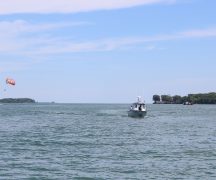By DAVID DUPONT
BG Independent News
Good news was in the forecast when NOAA announced this week its projection for the size of the harmful algae bloom in Lake Erie.
For the second year in a row the bloom is expected to be smaller than usual. That’s the first time in a decade that has occurred.
Rick Stumpf, the lead scientist at the National Oceanic and Atmospheric Administration’s National Centers for Coastal Ocean Science, issued the forecast in a webinar on Wednesday.
Still, the scientists participating in the webinar weren’t ready to start celebrating the end to the problem.
“This is from low flow, not a reduction in the actual concentration of nutrients going into the water,” Stumpf said.
The blooms are fed by nutrients – phosphorus and nitrogen – that flow down the Maumee River. The largest share of those nutrients come from fertilizer run-off from agricultural lands.
Lauren Johnson, who heads Heidelberg College’s long-standing National Center for Water Quality Research, said that between 248-272 metric tons of bioavailable phosphorus – the form that feeds the algae – is expected to flow down the Maumee this year. That’s lower than the two previous years.
At the lower end that just a little over the target of 240 metric tons set by Great Lakes Water Quality Agreement.
The Heidelberg project has automatic monitors that take three samples daily that are collected weekly at 22 sites in Ohio and one in Michigan.
Johnson attributed the low load of phosphorus on a small amount of rain in March, a dry April, one big storm in May, and spotty thunderstorms since then.
Without doing anything, “we are really close to that line,” she said.
While more rain means more of a nutrient load that was not the case in 2019. Then there was so much rain that farm fields were flooded, and many were never planted, so they weren’t fertilized.
What that year showed, Johnson said, is that a reduction in the load can have a rapid effect on the health of the lake.
That’s reassuring as the state tries to address the problem with its H2Ohio initiative.
Still Stumpf cautioned this turn for the better may not last. The weather goes in cycles. Now we may be in a dry period, he said. If the weather gets into a wet period, it’s hard to project what will happen. The extensive blooms could return if the concentration of nutrients flowing down the Maumee aren’t controlled.
Back in 2002 the target of reducing the nutrient load by 40 percent was set. If that had been met the load this year would be “negligible,” he said.
Dry years, Stumpf said, are an opportunity.
Much of the work in how to mitigate the flow of nutrients into the lake is being funded through the state’s H2Ohio fund. Chris Winslow, director of Ohio State’s Stone Lab, said it’s still too early to assess the impact of H2Ohio.
Lauren Kinsman, Kent State University, and a member of the Lake Erie Aquatic Research Network, reported on efforts to increase wetlands across the state. The projects is working on developing 55 wetland areas in the state, most concentrated in Northwest Ohio.
Wetlands are usually described as nature’s kidneys. But it’s not so simple, she said.
Wetlands can often serve as a sink where the nutrients are retained in the soil and don’t flow into the lake. However, it has been found that some wetlands can also be a source of nutrients flowing into the lake. And some may do a good job of holding phosphorus, but not so good holding nitrogen or vice versa.
One challenge for the project is to come up with ways of assessing how well the wetlands work.
Typically this has been done by monitoring visible elements, such as what plants are growing, what variety, and its size.
This kind of monitoring, Kinsman said, does not provide the information needed to guide the construction and maintenance of wetlands in the future.
This would involve measuring what’s in the plants and the soil. While this highly technical work in ongoing, the project will be gathering baseline data.
Meanwhile Stumpf said, “most of the lake will be fine most of the time.”
Some blooms will occur, and the wind moves them around. There are toxins in varying concentrations in the blooms, and especially when scum forms.
He cautioned that people should not go into the scum, and they should keep their dogs away. “It’s quite dangerous for dogs because they’re swimming at mouth level.”
Information on advisories can be found at the Ohio EPA’s website.





